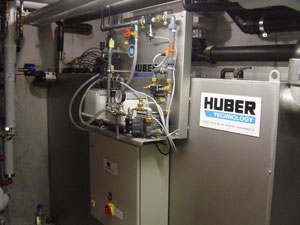Department Process Engineering
Single house wastewater treatment with water reuse
In most of the industrialized countries, wastewater is collected in large sewer systems and treated in centralized wastewater treatment plants. This system is beneficial for many reasons: infectious diseases spreading through deficient sanitary conditions have been eradicated, the wastewater is treated at one place under controlled conditions, the principle „out of sight, out of mind“ is very comfortable for the users.
But there are also some disadvantages:
- Groundwater is contaminated because of leaking pipes
- A high water consumption is required in order to ensure good flushing of the sewers
- The wastewater is diluted with uncontaminated water (rainwater, infiltrating groundwater)
- Costs
- The nutrient cycle is not closed (sewage sludge has to be burned in Switzerland)
It’s called into question, whether there are good alternatives to this conventional system, without changing the habits of the users nor confining the existing comfort.
The requirements of an alternative system are the following:
- little water consumption or water recycling
- low costs (construction, maintenance)
- no concessions regarding the effluent quality
- the same comfort for the users
Based on these considerations, the canton Solothurn and Eawag initiated the „Aquamin“ project. Within this project, a small-scale wastewater treatment plant was installed in a one-family building in Zuchwil, SO, which is monitored by Eawag. The main goals of the project include the safe operation, effluent quality, water recycling and energy consumption. The project should be finished by the end of 2007.

The treatment System
- Wastewater treatment plant: The plant consists of two reactors with a volume of 1.5 m3 each. The wastewater is purified biologically and withdrawn through a membrane with 0.04 um pore size. The question to answer is, how to operate the plant in order to minimize the pollutant load and energy consumption.
- Urine treatment: Urine is collected separately with NoMix toilets. Urine contains around 50% of the phosphate load. The phosphate is removed by precipitating struvite - a fertilizer (see NOVA 4). What we do not know is, how the combination of urine treatment and biological wastewater purification works.
- Sludge treatment: The pollutants are removed from the wastewater by biological activity. The activated sludge (mixture of water and microorgansims) needs to be removed from time to time. It is pumped into a filter bag which is located outside the building. The solids are retained while the water flows back to the treatment plant. Which pollutants accumulate in the sludge? Could we use it as compost?
- 4. Water recycling: The treated wastewater (permeate) is collected in a tank. It is reused for toilet-flushing and gardening, thus reducing the water consumption by 35%. Can this water be reused without problems? Are there substances accumulating in the system and do they influence the wastewater treatment?
Further questions considered are the user-friendliness, maintenance requirements (costs), operational stability, monitoring, water and energy consumption.
Publications
- Abegglen, C., Sigrist, A., Siegrist, H. „Electrochemical Phosphate Removal for Small-Scale Wastewater Treatment Plants”, Wat.Sci.Techn., submitted
- Abegglen, C., Joss, A., Boehler, M., Buetzer, S., Siegrist, H. (2009).
„Reducing the natural color of membrane bioreactor permeate with activated carbon or ozone”. Wat.Sci.Techn., accepted. - Abegglen, C. (2009). “Membrane bioreactor technology for decentralized wastewater treatment and reuse”, Diss. ETH No. 17998.
- Abegglen, C., Joss, A., McArdell, C.S., Fink, G., Schluesener, M.P., Ternes, T.A., Siegrist, H. (2009). “The fate of selected micropollutants in a single-house MBR”, Wat. Res. 43(7): 2036-2046.
- Abegglen, C., Ospelt, M., Siegrist, H. (2008). „Biological nutrient removal in a small-scale MBR treating household wastewater”, Wat.Res. 42(1-2): 338-346.
- Abegglen, C., Siegrist, H. (2006). “Domestic wastewater treatment with a membrane bioreactor”, Wat.Sci.Techn. 53(3), 69-78.
